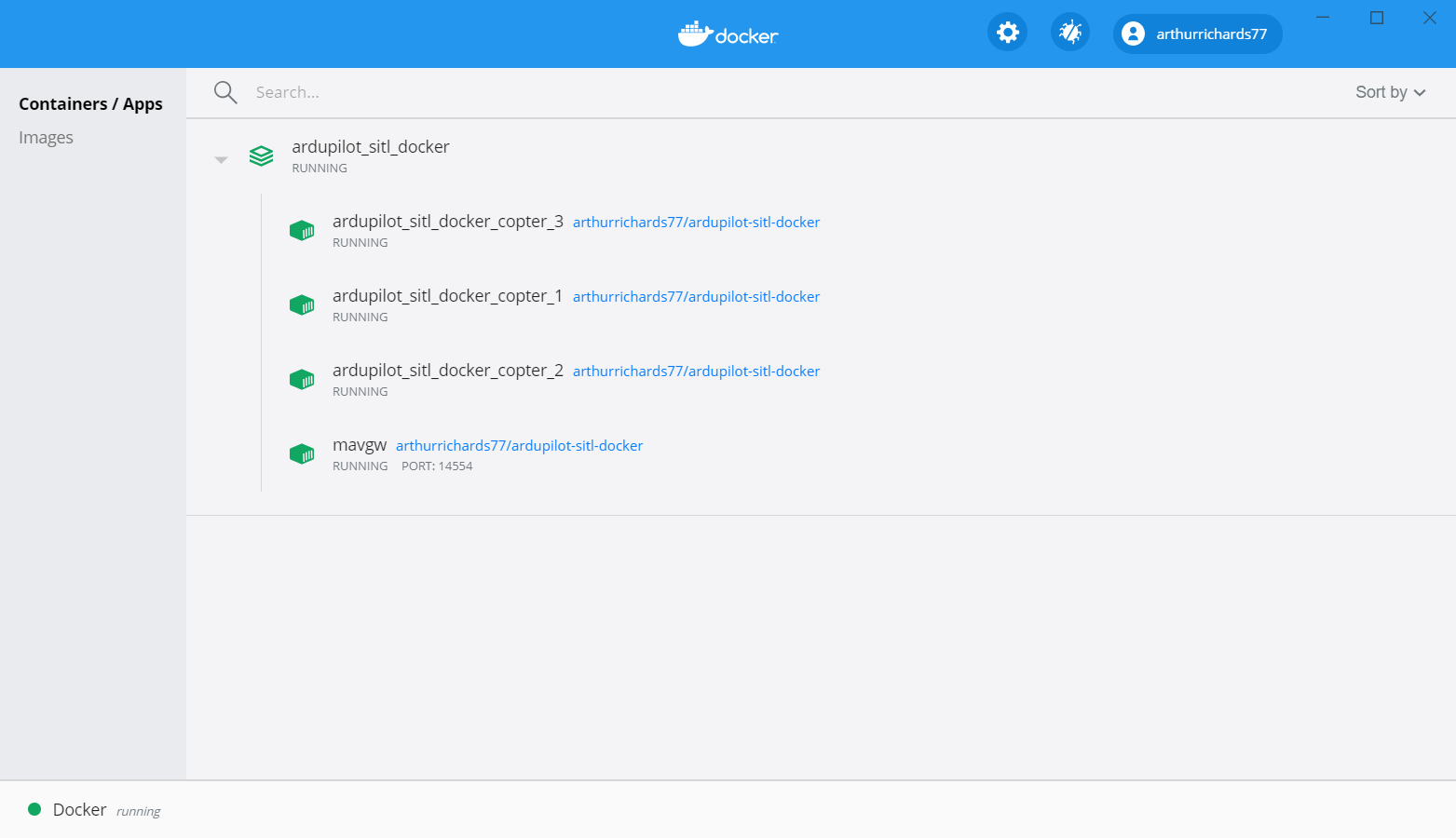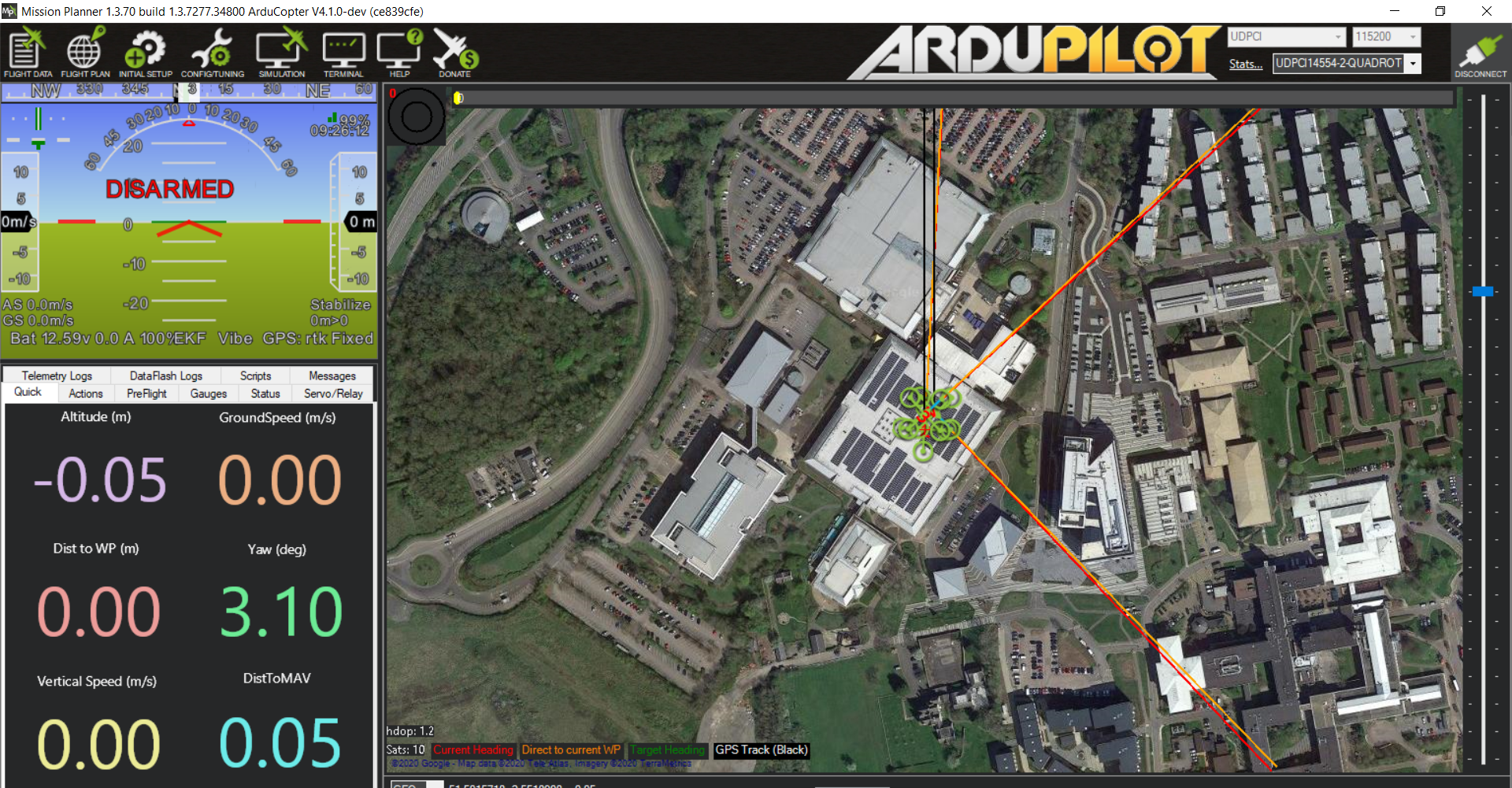(Yet another) container for Ardupilot Software-in-the-Loop simulation. This one targets multi-vehicle simulation by exploiting the new (Oct 2020) capability in Ardupilot to set the System ID via the command line. Details are in this commit.
By default, the container launches a copter SITL instance plus an accompanying Mavproxy.py instance, which forwards the Mavlink stream to a common UDP port. The copter will get its system ID from the last number of its Docker IP address, ensuring unique identities. By default, that port is 14553 on the gateway. Hence the following runs a single SITL:
docker run arthurrichards77/ardupilot-sitl-docker:latest
Then connect your multi-UAV-capable ground station as a listener to udp:localhost:14553 and you should get the data. Repeat the docker run command and you should see more copters appear on your GCS. I've tested using QGroundControl.
The container enables some customization via environment variables, including the SITL executable and command line options. For example, the following runs a plane simulation.
docker run -e SITL_EXE=arduplane -e SITL_OPTS='--model=plane --defaults=/home/pilot/ardupilot/Tools/autotest/default_params/plane.parm' arthurrichards77/ardupilot-sitl-docker:latest
Several docker-compose files are provided to support scaling up simulations. The default docker-compose.yml includes only copters, enabling the following as a way to launch multiple copters at once:
docker-compose up --scale copter=9
An alternative docker-compose.planes.yml enables multiple planes:
docker-compose -f docker-compose.planes.yml up --scale plane=5
A final docker-compose.mix.yml covers both at the same time.
docker-compose -f docker-compose.mix.yml up --scale plane=3 --scale copter=4
| QGroundControl will struggle with this, as it appears to assume all UAVs are of the same type. For example, you'll only get Copter modes in the drop-down.
docker-compose.gateway.udp.yml provides an additional MAVProxy service to route all MAVLINK to a common UDP port, 14554, which is exposed to the outside world from Docker. Connect your GCS as a UDP client to this port.
| An experimental docker-compose.gateway.yml provides an additional MAVProxy service to route all MAVLINK to a TCP server. I thought this would be an easier way to connect than intercepting UDP streams, especially for ambitions to run this in the cloud. However, it has extreme latency problems, to the point of beng unusable.
| Also docker-compose.gateway.pull.yml pulls the image from Docker hub instead of building it locally.
Different GCS software appears to have different quirks regarding types of network connections. These are the combinations I've got working.
Installation instructions for Docker on Windows can be found here. It's a little fiddly to get the Hyper-V stuff right and will demand a restart.
Use the UDP gateway stack and launch via docker-compose -f docker-compose.gateway.udp.yml up --scale copter=3. Open the Docker Desktop and the Containers/Apps screen should show as below, if you click on the expanding arrow next to ardupilot-sitl-docker. You can explore the resources and output of each element by clicking on its name.
Then fire up Mission Planner, select UDPCl (UDP client) as the connection type at top right, and hit connect. Enter 127.0.0.1 as host and 14554 as port number. It is rather slow to get going as downloading three sets of params takes on the order of a minute. You should see three copters as below.
You can fly the drones around by hand, using Guided mode. Use the drop-down box at the top right to choose which drone you're talking to. It's rather slow - be prepared to have to repeat commands.
| TODO: investigate reducing data rate and using alternative MAVLINK gateways such as mavp2p or MAVLink router.
I was using Ubuntu 18.04 and the latest QGC as of November 2020.
Use the default stack without the gateway: docker-compose up --scale copter=9
The launch QGC and add a connection on UDP listening to port 14553. You should see nine drones in different places. Select "Multi-UAV" in QGC using the radio button at top right and you should see nine little info screens. You can choose which drone to control using the drop-down at top centre.
| The combination of Linux and QGC seems to allow the UDP stream to be picked up outside Docker. I couldn't reproduce this on Windows or Mission Planner so it should be regarded as brittle.
| TODO: screenshots for Linux
The default command of the container runs a launch script which employs environment variables to enable customization. The full list of these is below, including their default settings. Of course, everything can be customized by overriding the command via Docker.
- SYSID : the target system ID, i.e.
--sysidof the drone in the range 1-255 : default is the last number of the IP address - STARTPOSE : the
--homelocation for the drone in format lat,lon,alt,yaw : default is line $SYSID from the file app/starts.txt - SITL_EXE : the executable filename from Ardupilot's
/build/sitl/binfolder : default isarducopter - SITL_OPTS : options for SITL besides
--homeand-sysid: default is--model=quad --defaults=/home/pilot/ardupilot/Tools/autotest/default_params/copter.parm - MAVLINK_OUT : forwarding address for MAVLINK packets, in format of
--outoption for MAVProxy : default isudp:$GATEWAY_IP:14553where$GATEWAY_IPis the address of the Docker network gateway to the host.
(https://hub.docker.com/r/edrdo/ardupilot-sitl-docker) was the inspiration for this work
See also (https://hub.docker.com/r/radarku/ardupilot-sitl) and many more found by searching on Docker hub.

